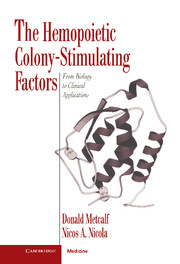Book contents
- Frontmatter
- Contents
- Preface
- 1 Historical introduction
- 2 General introduction to hemopoiesis
- 3 Key techniques in analyzing hemopoiesis
- 4 Biochemistry of the colony-stimulating factors
- 5 Biochemistry of the colony-stimulating factor receptors
- 6 Molecular genetics of the colony-stimulating factors and their receptors
- 7 Biological actions of the colony-stimulating factors in vitro
- 8 The biology of colony-stimulating factor production, degradation, and clearance
- 9 Actions of the colony-stimulating factors in vivo
- 10 Role of the colony-stimulating factors in basal hemopoiesis
- 11 Actions of the colony-stimulating factors in resistance to infections
- 12 Role of the colony-stimulating factors in other disease states
- 13 The colony-stimulating factors and myeloid leukemia
- 14 Clinical uses of the colony-stimulating factors
- 15 Conclusions
- References
- Index
6 - Molecular genetics of the colony-stimulating factors and their receptors
Published online by Cambridge University Press: 04 August 2010
- Frontmatter
- Contents
- Preface
- 1 Historical introduction
- 2 General introduction to hemopoiesis
- 3 Key techniques in analyzing hemopoiesis
- 4 Biochemistry of the colony-stimulating factors
- 5 Biochemistry of the colony-stimulating factor receptors
- 6 Molecular genetics of the colony-stimulating factors and their receptors
- 7 Biological actions of the colony-stimulating factors in vitro
- 8 The biology of colony-stimulating factor production, degradation, and clearance
- 9 Actions of the colony-stimulating factors in vivo
- 10 Role of the colony-stimulating factors in basal hemopoiesis
- 11 Actions of the colony-stimulating factors in resistance to infections
- 12 Role of the colony-stimulating factors in other disease states
- 13 The colony-stimulating factors and myeloid leukemia
- 14 Clinical uses of the colony-stimulating factors
- 15 Conclusions
- References
- Index
Summary
A new era in the study of the structure and biological activities of the colony-stimulating factors was ushered in by the molecular cloning of cDNAs encoding the CSFs and their cellular receptors, as well as the production of recombinant proteins. New insights into the physiology of CSF action have also been gained from the structures of the genes and promoter elements of the CSFs and their receptors. In some cases, the results have been unexpected, as was the case with multiple transcripts, all of which encode membrane-anchored forms of M-CSF. In other cases, such as alternative transcripts of CSF receptors that encode soluble forms, the results suggest novel mechanisms of biological regulation of CSF action. It is already clear that the control of CSF gene expression is extremely complex, with some mechanisms controlling RNA stability, others the constitutive transcription rate in different cells, and yet others the transcription rate inducible by biological regulators in a cell-specific manner. In this chapter, the chromosomal localization and structure of the CSF and receptor genes will be described along with the occurrence of alternative transcripts and the regulation of gene expression.
GM-CSF
The gene encoding human GM-CSF is on chromosome 5q21-31 (Huebner et al., 1985; Yang et al., 1988), and the corresponding mouse gene is on chromosome 11A5-B1 (Barlow et al., 1987) (Table 6.1). Both genes contain four exons and produce a single transcript of 780 bp (Miyatake et al., 1985; Stanley et al., 1985) (Figure 6.1). In both cases, control of GMCSF expression occurs both transcriptionally and post-transcriptionally as a result of conserved AT-rich sequences in the 3' untranslated region of the gene.
- Type
- Chapter
- Information
- The Hemopoietic Colony-stimulating FactorsFrom Biology to Clinical Applications, pp. 91 - 108Publisher: Cambridge University PressPrint publication year: 1995

